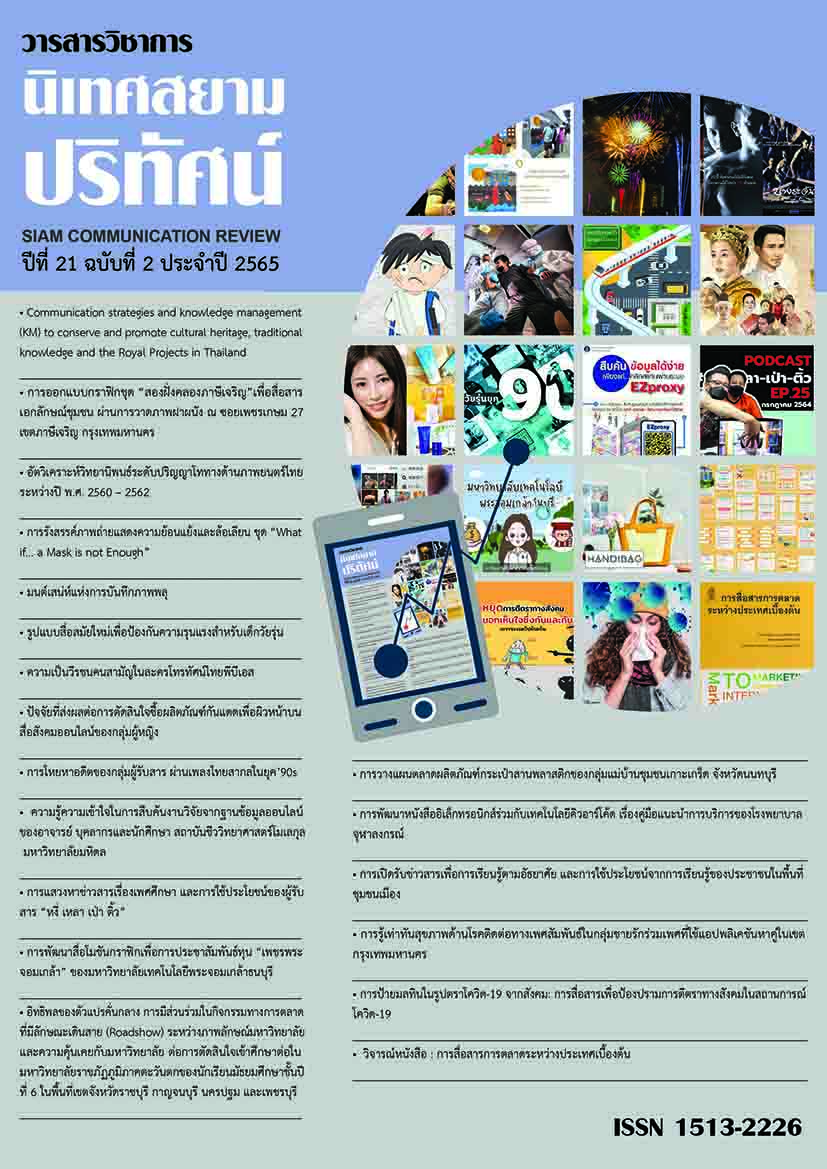The Stigma in the Form of a ‘Badge’ on COVID-19 by Society :The Communication to Reduce Social Stigma in the COVID-19 Situation
Main Article Content
Abstract
The situation of COVID-19 is a public health problem that affects a wide range. It is coupled with an emerging disease. Therefore, official information about the epidemic is limited. This causes most people in society to have anxiety, paranoia, and fear that they or their loved ones will be infected. There is confusion in the information, thus leading to social stigma. causes of stigma in Thai society amid the COVID-19 situation. It was found that there were both internal and environmental factors that caused incorrect perceptions of people infected with COVID-19. Social stigma affects the identity of the infected and presumed infected at the individual level in terms of physical, mental, social, and community impacts and has an impact on disease control.
The article suggests communication guidelines for reducing social stigma, which include: 1.Communication that considers the human being and avoids communication that causes negative feelings. 2. Communication by prioritization, collection, classification, dissemination, and validation of information. 3. Communication based on the unity of trustworthy agents and accredited sources 4.Professional ethical media communication and personal data protection 5.Use social media to build a supportive social network.
Article Details

This work is licensed under a Creative Commons Attribution-NonCommercial-NoDerivatives 4.0 International License.
References
กรมประชาสัมพันธ์. (2563). คู่มือการปฏิบัติงานของสื่อมวลชนด้านการสื่อสารในภาวะวิกฤต. กรุงเทพมหานคร: เปเปอร์เฮ้าส์.
เกศินี วุฒิวงศ์. (2563). มาตรการป้องกันเพื่อลดปัญหาการตีตราทางสังคมในมหาวิทยาลัยในประเทศไทยช่วงการระบาดของโรคโควิด 19. วารสารมหาวิทยาลัยพายัพ, 30(2), 1-14.
สุภลักษณ์ ธานีรัตน์, เมทณี ระดาบุตร, สุจิรา วิเชียรรัตน์ และศิริพร โอภาสวัตชัย. (2563). กลยุทธ์เพื่อลดการตีตราทางสังคมในสถานการณ์โควิด-19. วารสารเกื้อการุณย์. 27(2). 164-174.
Blaine, B. E., & Brenchley, K. J. J. M. C. (2018). Understanding the Psychology of Diversity. Thousand Oaks: SAGE Publications.
Ho, C. S., Chee, C. Y., & Ho, R. C. (2020). Mental Health Strategies to Combat the Psychological Impact of COVID-19 Beyond Paranoia and Panic. Annals of the Academy of Medicine, Singapore, 49(3), 155–160.
กรมควบคุมโรค. (2563). รายงานสถานการณ์โควิด-19 [รายงาน]. เข้าถึงได้จาก https://covid19.ddc.moph.go.th/
ความรู้-ความเข้าใจ ทางออกสังคม ลดตีตราผู้ป่วยโควิด-19. (2563, 29 เมษายน). กรุงเทพธุรกิจ. เข้าถึงได้จากhttps://www.bangkokbiznews.com/recommended/detail/2143
ไทยดีไอแมชีน. (2564, 2 เมษายน). DIRU นิเทศ จุฬาฯ เปิดตัว “ไทยดีไอแมชีน” กระตุ้นสังคม ชวนคิดตรวจสอบก่อนแชร์ข่าวปลอม [ข่าว]. เข้าถึงได้จาก https://www.chula.ac.th/news/45266/
นิด้าโพล. (2564, 7 กุมภาพันธ์) . COVID-19 รอบใหม่ [ผลโพล]. เข้าถึงได้จากhttps://nidapoll.nida.ac.th/survey_detail?survey_id=490
บีบีซี. (2564, 12 กุมภาพันธ์). โคโรนา: อนามัยโลกตั้งชื่อ โควิด-19 ให้โรคทางเดินหายใจจากไวรัสสายพันธุ์ใหม่ [รายงานข่าว]. เข้าถึงได้จาก https://www.bbc.com/thai/features-51473472
บีบีซี. (2564, 1 ธันวาคม). โควิด: WHO ให้ชื่อ "โอไมครอน" สายพันธุ์ใหม่ที่พบแถบแอฟริกาใต้ หลายชาติกลับมาจำกัดการเดินทาง [รายงานข่าว]. เข้าถึงได้จาก https://www.bbc.com/thai/international-59428316
แพทยสภา. (2558, 12 สิงหาคม). คำประกาศสิทธิและข้อพึงปฏิบัติของผู้ป่วย. เข้าถึงได้จาก https://www.tmc.or.th/privilege.php
ภาคภูมิ แสวงคำ. (2563, 19 พฤษภาคม). ระยะห่างระหว่างการลงโทษทางสังคมกับการคุ้มครองข้อมูลส่วนบุคคลในสถานการณ์โรคโควิด-19 [บทความ]. เข้าถึงได้จาก http://www.thaingo.in.th/news/?p=content&act=detail&id_content=4982
ภานุเมศ ตันรักษา. (2563, 2 กุมภาพันธ์). อย่าให้ไวรัสโคโรนามาสร้างความเกลียดชังให้พี่น้องไทยจีน [บทความ]. เข้าถึงได้จาก https://www.posttoday.com/social/general/613618
ราชวิทยาลัยจิตแพทย์แห่งประเทศไทย. (2563, 18 มีนาคม). ประกาศราชวิทยาลัยจิตแพทย์แห่งประเทศไทยที่ 8/2563 เรื่องคําแนะนําในการดูแลจิตใจช่วงการระบาดของไวรัส โควิด-19 [ประกาศ]. เข้าถึงได้จาก https://drive.google.com/file/d/1PEvxrXhu8s8QRwOUDut1H0qxehe2Da1H/view?fbclid=IwAR3wYuwh3E3bdrQBMK9K1v78M7FsOtXOKG8yh CeVBU0hwDO09aM52FGMnjU.
สถาบันวิจัยสังคม จุฬาลงกรณ์มหาวิทยาลัย. (2548). บทสรุปสำหรับผู้บริหาร การศึกษาวิจัยเรื่องการเลือกปฏิบัติในการประกอบอาชีพของผู้ติดเชื้อเอชไอวี. เข้าถึงได้จาก http://www.nhrc.or.th/getattachment/2c1336d2-df10-4a08-9f49-4ea5360a24f8/.aspx
สำนักงานสถิติแห่งชาติ. (2563). ผลสำรวจสถานการณ์การแพร่ระบาดของโรคโควิดด้านสังคม. เข้าถึงได้จาก http://ittdashboard.nso.go.th/preview_covid19_social.php
Abdelhafiz, A. S., & Alorabi, M. (2020). Social Stigma: The Hidden Threat of COVID-19. Frontiers in public health, 8, 429. Retrieved from https://doi.org/10.3389/fpubh.2020.00429
AlNaamani, K., AlSinani, S., & Barkun, A. N. (2020). Medical research during the COVID-19 pandemic. World journal of clinical cases, 8(15), 3156–3163. Retrieved from https://doi.org/10.12998/wjcc.v8.i15.3156
Bagcchi, S. (2020). Stigma during the COVID-19 pandemic. The Lancet. Infectious diseases, 20(7), 782. Retrieved from https://doi.org/10.1016/S1473-3099(20)30498-9
Bhattacharya, P., Banerjee, D., & Rao, T. S. (2020). The “Untold” Side of COVID-19: Social Stigma and Its Consequences in India. Indian Journal of Psychological Medicine, 42(4), 382–386. Retrieved from https://doi.org/10.1177/0253717620935578
Brooks, S. K., Webster, R. K., Smith, L. E., Woodland, L., Wessely, S., Greenberg, N., & Rubin, G. J. (2020). The psychological impact of quarantine and how to reduce it: rapid review of the evidence. Lancet (London, England), 395(10227), 912–920. Retrieved from https://doi.org/10.1016/S0140-6736(20)30460-8
Bruns, D. P., Kraguljac, N. V., & Bruns, T. R. (2020). COVID-19: Facts, Cultural Considerations, and Risk of Stigmatization. Journal of transcultural nursing: official journal of the Transcultural Nursing Society, 31(4), 326–332. Retrieved from https://doi.org/10.1177/1043659620917724
Centers for Disease Control and Prevention. (2021). Addressing Stigma. Retrieved from https://emergency.cdc.gov/cerc/cerccorner/article_123016.asp.
Corrigan P,. (2021). On the Stigma of COVID-19 : Let’s separate the illness from the patient. Retrieved from https://www.psychologytoday.com/us/blog/the-stigma-effect/202004/the-stigma-covid-19
Dwinantoaji, H., & DW, S. (2020). Human security, social stigma, and global health: the COVID-19 pandemic in Indonesia. Journal of the Medical Sciences (Berkala ilmu Kedokteran), 52(3). Retrieved from https://doi.org/10.19106/JMedSciSI005203202014
IFRC, Unicef & World Health Organization. (2021). Social Stigma associated with COVID- 19 [Article]. Retrieved from https://www.unicef.org/sites/default/files/202003/Social%20stigma%20associated%20with%20the%20coronavirus%20disease%202019%20%28COVID-19%29.pdf.
Nochaiwong, S., Ruengorn, C., Awiphan, R., Ruanta, Y., Boonchieng, W., Nanta, S.,et al.(2020). Mental health circumstances among health care workers and general public under the pandemic situation of COVID-19 (HOME-COVID-19). Medicine, 99(26), e20751. Retrieved from https://doi.org/10.1097/MD.0000000000020751
Sotgiu, G., & Dobler, C. C. (2020). Social stigma in the time of coronavirus disease 2019. The European respiratory journal, 56(2). Retrieved from https://doi.org/10.1183/13993003.02461-2020
World Health Organization. (2021). Naming SARS-CoV-2 variants [Article]. Retrieved from https://www.who.int/en/activities/tracking-SARS-CoV-2-variants/
World Health Organization, UNICEF, IRPC. (2021). Social stigma associated with the coronavirus disease (COVID-19) [Article]. Retrieved from https://www.who.int/docs/default-source/coronaviruse/covid19-stigma-guide.pdf?sfvrsn=226180f4_2


